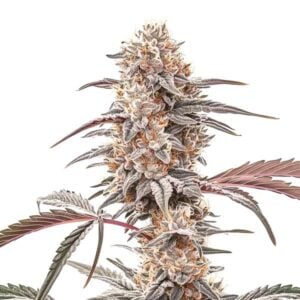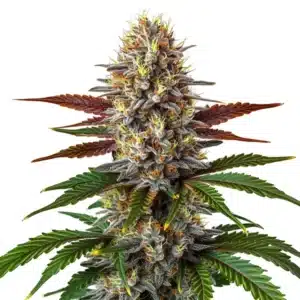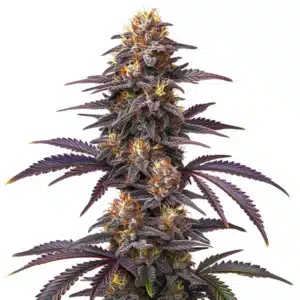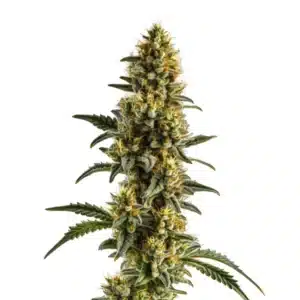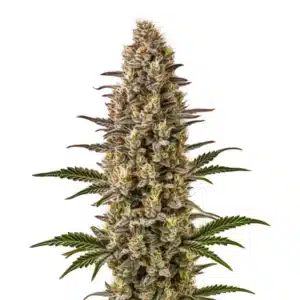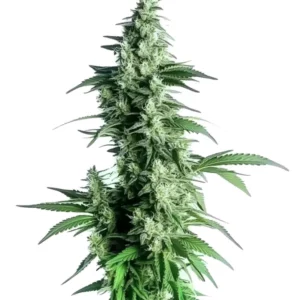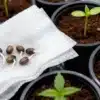
How to Feminize Cannabis Seeds
Unlock the Full Potential of Feminized Cannabis Seeds
Diving into the world of cannabis cultivation, one quickly discovers the vital role feminized cannabis seeds play in achieving abundant, high-quality yields. If you’ve been wondering how to feminize cannabis seeds effectively, you’re in the right place. The science and methods behind this process can transform your grow experience from good to extraordinary.
What Exactly Are Feminized Cannabis Seeds?
Feminized cannabis seeds are specifically bred to eliminate male chromosomes, ensuring that every plant grown from these seeds is a female. This is crucial for cultivators focused on harvesting the resinous buds that female plants produce. Male plants, on the other hand, are primarily useful for breeding purposes and can pollinate females, leading to seed production rather than the desired bud formation.
Recommended Strains
Biscotti
|
|
THC | 25% - 30% (High) |
|
|
Type | Feminized |
|
|
Yield | Medium |
|
|
Phenotype | 80% Indica / 20% Sativa |
Biscotti Mintz
|
|
THC | 22% - 25% (Medium) |
|
|
Type | Feminized |
|
|
Yield | High |
|
|
Phenotype | 80% Indica / 20% Sativa |
Female plants produce the buds that are rich in cannabinoids and terpenes, the compounds responsible for the plant’s therapeutic and psychoactive effects. By ensuring that all your plants are female, you maximize the production of these valuable buds.
The Benefits of Using Feminized Seeds
Utilizing feminized seeds comes with a plethora of benefits, primarily centered around yield and efficiency. Since these seeds are virtually guaranteed to produce female plants, growers can maximize their space and resources, focusing solely on nurturing plants that will yield consumable buds. This eliminates the labor and time involved in identifying and removing male plants, streamlining the cultivation process.
Additionally, feminized seeds allow for more predictable and consistent crop outcomes. Knowing that each seed will result in a bud-producing plant makes it easier to plan harvests, estimate yields, and manage space effectively. This predictability is especially valuable for commercial growers who need to maintain steady production schedules and quality standards.
Using feminized seeds also reduces the risk of accidental pollination, which can ruin a crop by producing seeds instead of the desired buds. This is a significant advantage for growers aiming to produce sinsemilla, or seedless cannabis, which is prized for its potency and quality.
Common Misconceptions About Feminized Seeds
Despite their advantages, several misconceptions surround feminized seeds. One prevalent myth is that feminized seeds are genetically modified. In reality, feminized seeds are created through traditional breeding techniques, not genetic engineering. Another misconception is that feminized plants are less robust than regular ones. While it’s true that feminized plants can be sensitive to stress, proper care and optimal growing conditions can produce resilient and high-yielding crops.
Some growers worry that feminized seeds may be more prone to hermaphroditism. While it’s true that stress can cause any cannabis plant to develop hermaphroditic traits, feminized seeds are not inherently more susceptible. Careful cultivation practices can minimize this risk and ensure healthy, productive plants.
Promos & Deals
Proven Methods to Feminize Cannabis Seeds
Achieving feminization in cannabis seeds relies on a solid grasp of plant biology and the precise use of specialized techniques. Whether you’re just starting out or have years of experience, learning the different ways to feminize cannabis seeds can greatly improve your chances of successful cultivation.
How to Feminize Cannabis Seeds: The Importance of Feminization in Cannabis Cultivation
Feminization is crucial because it ensures that you’re maximizing your efforts and resources. Male plants do not produce buds and can ruin a crop by pollinating female plants, leading to seed production instead of bud formation. By feminizing your seeds, you ensure that each plant in your garden contributes to the final harvest, making the entire process more efficient and productive.
Feminization also allows for better control over your grow environment. With all-female plants, you can optimize your setup for bud production, including light schedules, nutrient regimens, and space allocation. This targeted approach leads to higher quality and more abundant yields.

How to Feminize Cannabis Seeds: Stress-Induced Feminization
One natural method to induce feminization involves stressing female plants. This can be done through techniques such as light manipulation or physical stressors. When a female plant senses it might not survive, it can produce male flowers to self-pollinate, ensuring the survival of its genetics. However, this method can be unpredictable and may result in plants that are more prone to hermaphroditism.
Stress-induced feminization can involve techniques such as:
- Light manipulation: Interrupting the dark cycle with brief periods of light can stress the plant into producing male flowers.
- Physical stress: Techniques like bending or damaging branches can also induce stress, leading to the development of male flowers.
While these methods can be effective, they require precise control and monitoring to avoid excessive stress that could harm the plant.
How to Feminize Cannabis Seeds: Chemical Methods for Seed Feminization
Chemical methods provide a more controlled approach to seed feminization. These methods involve applying substances that inhibit ethylene production, a hormone that regulates female flower development. By suppressing ethylene, the plant is encouraged to produce male flowers.
How to Feminize Cannabis Seeds: Using Colloidal Silver to Feminize Seeds
Colloidal silver is a popular and effective chemical used to feminize cannabis seeds. This method involves spraying a colloidal silver solution on female plants. The silver particles interfere with ethylene production, causing the plant to develop male flowers. These male flowers then produce pollen that can be used to fertilize other female plants, resulting in seeds that carry only female chromosomes.
The process of using colloidal silver includes:
- Preparation: Create or purchase a colloidal silver solution with a concentration of 30 ppm.
- Application: Spray the solution on the plant’s bud sites daily, starting when the plant begins to flower.
- Observation: Continue spraying for two to three weeks, monitoring the plant for the development of male flowers.
- Collection: Once male flowers appear, collect the pollen and use it to fertilize other female plants.
How to Feminize Cannabis Seeds: Using Gibberellic Acid for Seed Feminization
Gibberellic acid is another chemical used to induce male flower production in female plants. Similar to colloidal silver, it disrupts ethylene production. However, gibberellic acid must be used with caution as it can cause excessive stretching and affect the overall health of the plant. Careful application and monitoring are essential for success with this method.
Gibberellic acid application involves:
- Preparation: Dilute gibberellic acid to a concentration of 100 ppm.
- Application: Apply the solution to the bud sites daily for several weeks.
- Monitoring: Watch for the development of male flowers and ensure the plant remains healthy.
- Collection: Collect pollen from the male flowers to fertilize other female plants.
Step-by-Step Guide to Feminizing Cannabis Seeds
Achieving successful feminization requires meticulous planning and execution. Below is a comprehensive guide to help you through the process of how to feminize cannabis seeds.

Selecting the Right Strain for Feminization
Choosing the right strain is the first critical step in how to feminize cannabis seeds. Look for strains known for their stability and resilience. Strains with a high tendency for hermaphroditism should be avoided, as they can pass this trait onto their offspring, leading to issues in future generations.
When selecting a strain, consider factors such as:
- Genetic stability: Choose strains with a history of stable genetics and low incidence of hermaphroditism.
- Desired traits: Select strains with the characteristics you want, such as high THC content, specific terpene profiles, or particular growth habits.
- Reputation: Research strains that have been successfully feminized by other growers and have positive reviews.
Preparing Your Plants for Feminization
Before applying any feminization technique, ensure your plants are healthy and robust. Adequate nutrition, proper light cycles, and optimal environmental conditions are crucial. A stressed or weak plant is less likely to respond well to feminization efforts.
Preparation steps include:
- Nutrition: Provide a balanced diet with appropriate nutrients for the plant’s growth stage.
- Light: Ensure consistent light schedules, with 18 hours of light during the vegetative stage and 12 hours during flowering.
- Environment: Maintain stable temperatures, humidity levels, and airflow to create an ideal growing environment.
Applying Colloidal Silver: A Detailed Process
When using colloidal silver to feminize cannabis seeds, start by preparing a solution with a concentration of 30 ppm (parts per million). Spray this solution on the chosen female plant’s bud sites daily, starting when the plant enters the flowering stage. Continue this process for two to three weeks until male flowers begin to form. Collect the pollen from these flowers for fertilization.
Detailed steps include:
- Solution Preparation: Create or buy a colloidal silver solution with a 30 ppm concentration.
- Daily Spraying: Apply the solution to the bud sites every day, starting from the first day of flowering.
- Observation: Monitor the plants daily, continuing to spray for two to three weeks.
- Pollen Collection: Once male flowers appear, collect the pollen carefully to avoid contamination.
Harvesting and Drying Feminized Seeds
Once pollination is successful, female plants will produce seeds over the next few weeks. Allow these seeds to mature fully before harvesting. The seeds should be hard and dark in color. After harvesting, dry the seeds thoroughly to prevent mold and ensure longevity.
Steps to harvest and dry seeds:
- Pollination: Ensure the female plants are pollinated with the collected pollen.
- Maturation: Allow seeds to mature on the plant, typically for four to six weeks.
- Harvesting: Collect seeds when they are hard and dark.
- Drying: Dry the seeds in a cool, dark place to prevent mold.
Storing Feminized Seeds for Optimal Longevity
Proper storage is essential for maintaining the viability of feminized seeds. Store seeds in a cool, dark place with low humidity. Vacuum-sealed containers or jars with desiccant packs are ideal for keeping seeds dry and preventing exposure to light and moisture, which can degrade their quality.
Storage tips include:
- Containers: Use airtight containers or vacuum-sealed bags.
- Environment: Store in a cool, dark place with stable temperatures.
- Humidity Control: Include desiccant packs to maintain low humidity levels.
Troubleshooting Common Issues in Feminizing Cannabis Seeds
Even with the best techniques, challenges can arise during the feminization process. Being able to identify and address these issues promptly is key to maintaining a healthy crop when learning how to feminize cannabis seeds.
Identifying Hermaphrodites in Your Crop
Hermaphroditism can occur when plants experience stress or genetic instability. Regularly inspect your plants for signs of male flowers, which can develop alongside female buds. Early detection and removal of hermaphroditic plants are crucial to prevent unwanted pollination.
Signs of hermaphroditism include:
- Banana-shaped growths: Male flowers can appear as small, yellow structures.
- Pollen sacs: Look for small, ball-shaped structures that may develop alongside female buds.
Preventing and Managing Stress-Induced Hermaphroditism
Minimizing stress is essential for preventing hermaphroditism. Maintain stable environmental conditions, avoid over-pruning, and ensure consistent light schedules. If stress-induced hermaphroditism occurs, promptly remove affected plants and review your growing conditions to identify and mitigate stress factors.
Stress management tips include:
- Environment: Keep temperature, humidity, and light conditions stable.
- Handling: Avoid excessive handling or pruning of plants.
- Observation: Regularly monitor plants for signs of stress and address issues immediately.
Ensuring Genetic Stability in Feminized Seeds
Genetic stability is paramount for producing reliable feminized seeds. Start with high-quality genetics and avoid overuse of chemical feminization methods, which can increase the risk of genetic mutations. Implementing a rigorous selection process for parent plants can help ensure the stability and quality of future generations.
Ensuring stability involves:
- High-quality genetics: Begin with stable, well-documented strains.
- Selective breeding: Choose plants with desirable traits and minimal hermaphroditic tendencies.
- Controlled feminization: Use chemical methods judiciously to avoid genetic instability.
Maximizing Yield with Feminized Seeds
To get the most out of your feminized seeds, adopting best practices and optimizing growing conditions is essential. Here’s how to maximize your yield when learning how to feminize cannabis seeds.
Best Practices for Growing Feminized Seeds
Begin with healthy seedlings and provide them with optimal growing conditions. This includes using high-quality soil or hydroponic systems, maintaining proper pH levels, and ensuring adequate nutrient intake. Regular monitoring and adjustments can help keep your plants in peak condition throughout their lifecycle.
Best practices include:
- Quality medium: Use high-quality soil or hydroponic systems to support robust growth.
- Nutrient balance: Provide nutrients tailored to each growth stage.
- pH levels: Maintain appropriate pH levels to ensure nutrient uptake.
Optimizing Light, Water, and Nutrient Intake
Light, water, and nutrients are the three pillars of successful cannabis cultivation. Ensure your plants receive the right amount of light—typically 18 hours during the vegetative stage and 12 hours during flowering. Watering should be consistent but not excessive, and nutrients should be tailored to the plant’s growth stage. Using high-quality fertilizers and supplements can enhance plant health and yield.
Optimization tips include:
- Light schedules: Provide consistent light during vegetative and flowering stages.
- Watering: Ensure adequate but not excessive watering.
- Nutrient regimen: Use fertilizers and supplements designed for cannabis.
Effective Pest and Disease Management for Feminized Plants
Pests and diseases can severely impact your crop if not managed properly. Regularly inspect plants for signs of pests like spider mites, aphids, and caterpillars. Implement integrated pest management strategies, such as introducing beneficial insects, using organic pesticides, and maintaining a clean growing environment. Disease prevention involves proper ventilation, humidity control, and the use of disease-resistant strains.
Management strategies include:
- Regular inspections: Monitor plants frequently for signs of pests and diseases.
- Integrated Pest Management (IPM): Use a combination of biological, physical, and chemical controls.
- Clean environment: Maintain cleanliness to prevent infestations and diseases.
Legal and Ethical Considerations in Feminizing Cannabis Seeds
The legal and ethical implications of cannabis cultivation is crucial for any responsible grower, especially when learning how to feminize cannabis seeds.
Local Cannabis Cultivation Laws
Laws related to cannabis cultivation differ significantly depending on the region. Before beginning your grow, make sure you’re aware of local regulations to stay within legal boundaries. This includes knowing the limits on plant numbers, licensing requirements, and restrictions on where cultivation is allowed.
Key considerations include:
- Regulatory compliance: Understand and adhere to local cultivation laws.
- Plant limits: Be aware of legal limits on the number of plants you can grow.
- Licensing: Obtain necessary permits and licenses for cultivation.
Ethical Implications of Seed Feminization
Feminizing seeds is generally considered an ethical practice, as it enhances the efficiency and productivity of cannabis cultivation. However, ethical concerns can arise regarding the use of chemicals and the potential impact on genetic diversity. Responsible growers should consider the environmental and genetic implications of their practices.
Ethical considerations include:
- Chemical use: Use feminization chemicals responsibly to minimize environmental impact.
- Genetic diversity: Promote genetic diversity by avoiding over-reliance on a single feminization method.
- Sustainability: Implement sustainable practices to ensure long-term viability of cannabis cultivation.

The Future of Feminized Seeds in the Cannabis Industry
The future of feminized seeds looks promising, with ongoing advancements in breeding techniques and growing practices. As the cannabis industry continues to evolve, feminized seeds will likely play an increasingly vital role in meeting the demand for high-quality, consistent cannabis products. Embracing these innovations while maintaining ethical and sustainable practices will be key to the industry’s long-term success.
Future trends include:
- Breeding advancements: Ongoing research and development of new feminization techniques.
- Sustainable practices: Increased focus on environmentally friendly cultivation methods.
- Market growth: Expanding demand for feminized seeds as the cannabis industry continues to grow.
By mastering how to feminize cannabis seeds, you can elevate your cultivation skills, ensuring bountiful harvests and top-tier quality. Whether you’re just starting or aiming to improve your techniques, learning and applying these methods will guide you toward becoming a proficient and successful cannabis grower.
FAQs
What are feminized cannabis seeds, and why are they important?
Feminized cannabis seeds are specially bred to produce only female plants, eliminating the risk of male plants pollinating your crop. Female cannabis plants are the ones that develop resinous buds rich in cannabinoids and terpenes, which are highly valued for their potency and effects. Using feminized seeds ensures growers maximize their space and resources for high-quality yields.
How can I feminize cannabis seeds at home?
Feminizing cannabis seeds can be achieved through natural stress techniques or chemical methods. Popular chemical methods include applying colloidal silver or gibberellic acid to female plants, forcing them to produce male flowers that carry only female chromosomes. These methods require careful monitoring and application to ensure healthy, viable feminized seeds.
Are feminized cannabis seeds less reliable or prone to hermaphroditism?
Feminized seeds are not inherently less reliable than regular seeds. However, poor cultivation practices or excessive plant stress can increase the risk of hermaphroditism in any cannabis plant. Choosing stable genetics and maintaining optimal growing conditions are key to avoiding these issues and ensuring a healthy, productive crop.


